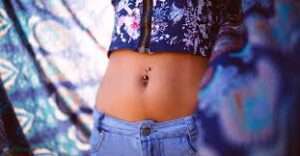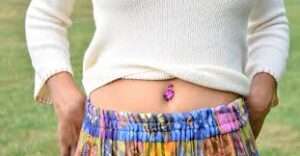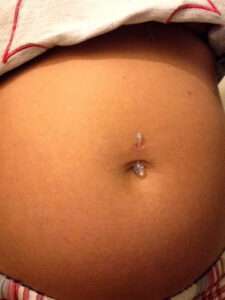Get information on belly button piercing after pregnancy and how to care for it.
Belly button piercing after pregnancy
After pregnancy, your belly button isn’t quite the same as it used to be. The piercing might have stretched out or even disappeared completely. Here are some things you can do to get that belly button looking like new again.
The first thing you should know is that if you want your belly button back the way it was before, you will need a surgery called an umbilicoplasty which tightens up the muscles and skin around the area of the original piercing.
This process is costly and has about a 50% chance of working successfully for returning navel piercings after pregnancy. Another option would be laser surgery but this also has its downsides such as scarring, risk of infection at the site of treatment.

The belly button piercing is a trend that has been around for some time now. It’s an extremely popular choice among young women, but it’s also common to see older women with belly rings as well.
Belly button piercing is a popular form of body modification. The piercing is usually done in the navel area, however it can also be pierced at other spots on the abdomen or even lower. There are a few reasons for this type of piercing: to commemorate an event, as a right of passage into adulthood or simply because you want one. Well, there may be some risks involved.
In fact, belly button piercings during pregnancy could lead to complications such as infection and inflammation around your uterus. These conditions can cause placental abruption (when the placenta separates prematurely) which can result in significant bleeding.
It may take some time for things to return to normal, but there are many ways you can help speed up the process.
Mothers may notice a few changes to their body after giving birth. One of these changes is the appearance of the belly button, which can change from a round shape to a smaller and more oval-shaped opening. This can happen as a result of stretching during pregnancy or from frequent contact with the baby’s head on the stomach area while pregnant.
In some cases, mothers may experience an umbilical hernia as well as loose abdominal muscles that create what appears to be an outie belly button instead of an innie one.

It’s understandable, your belly button has never been stretched out like this before. But don’t worry, it will go back to normal with time and patience. Here are some tips for how you can help speed up the process:
- Do not wear tight clothing around your stomach area this will keep your skin from stretching back in place.
- Stay hydrated by drinking plenty of water- this helps maintain elasticity in the skin and tissue under the abdominal muscles. (And it also keeps you feeling full).
- If you’re breastfeeding, drink an extra glass of water before each feeding to avoid dehydration during lactation.
Every woman’s body heals differently depending on her weight gain during pregnancy, for many women the skin around their navel will shrink back in and create a small scar. It may take up to six months or more for your navel to return to its pre-pregnancy size and shape.
Will my belly button ever go back to normal after pregnancy?
After pregnancy, many women are left with an outie belly button instead of the normal innie. It is not until months after giving birth that your belly button will return to its original state. Although it takes time for this transformation to happen, there are some things you can do in the meantime to help speed up the process and ease discomfort.
When you are pregnant, your belly button pops out because it is stretching. This usually goes back to normal after the baby comes out and the skin has time to tighten up again.

Pregnancy is an exciting time for expecting mothers, but it can also be a little bit scary. One of the biggest concerns that many women have during pregnancy is losing their belly button after giving birth.
How long does it take for a belly button piercing to close up?
If you want to get a belly button piercing, it’s important to know how long it takes for the wound to heal. A new belly button piercing can close up in as little as three months or take several years before closing completely.
There are many factors that contribute to the duration of time needed for healing, including where on your stomach you get pierced and how often you clean the area while healing. If your body decides not to close properly, there is also a chance of infection which could lead to scar tissue formation if left untreated.
Piercing your belly button is a personal choice. There are many factors that will affect how long it takes for the piercing to close up, including what type of jewelry you choose and how well you take care of the area around your navel.

The first thing that people should think about before getting their navel pierced is whether or not they can handle having one more hole in their body. Although it may seem like an easy decision at first, there are other factors people should consider before going through with this process. One factor is pain tolerance; while most piercings don’t hurt too much.
A belly button piercing is a great way to show off your individuality and style. However, it can be quite painful and take up to 3 months for the hole to close back up.
A piercing is a hole made in the body to insert jewelry. It’s not uncommon for piercings to close up.If your belly button piercing is closed up, you may be able to re-pierce it at no cost or with a very small fee. The length of time it takes for a belly button piercing to close depends on how well you take care of it and if you re-pierce after the first one closes.
Clean your piercing twice daily with saline solution or antibacterial soap. This will keep all bacteria out so that infection doesn’t form around the site of the wound.
Piercings are a great way to express yourself and your personal style. It is also an easy way to make new friends at the parlor you go to.
Read More:
- When do puppies open their eyes?
- Can you eat peach skin?
- Black spots on teeth that aren’t cavities
- What does salmon taste like?
- Fibrous papule of the nose
- Pinprick red dots on skin not itchy

